From U.S. Fish and Wildlife Service, Mountain-Prairie Region:
A green-winged teal comes down for a picture-perfect landing at Seedskadee #WildlifeRefuge. (Tom Koerner / #USFWS)
Protecting natural resources, including air, land and water. Also of interest are threatened and endangered species as well as endangered species. Conservation (wildlife, soil, water, etc.) issues also discussed. Topics include: RCRA, CERCLA, Clean Water Act (CWA), NEPA, 404 Permits, EPCRA, FIFRA, and others.
Search This Blog
Thursday, March 31, 2016
Florida woman comes face-to-face with rare panther on nature trail (VIDEO) — RT USA
A woman in Florida had a rare and amazing close encounter with one of the most endangered mammals on the planet ‒ a Florida panther ‒ while out on an early morning stroll.
Florida woman comes face-to-face with rare panther on nature trail (VIDEO) — RT USA
Florida woman comes face-to-face with rare panther on nature trail (VIDEO) — RT USA
Wednesday, March 30, 2016
Rattlesnake
From the Bureau of Reclamation:
In spring rattlesnakes frequent the rock structure at the MSCP's Beal Lake Conservation Area. Reclamation photo by Alexander Stephens.#wildlifewednesday
In spring rattlesnakes frequent the rock structure at the MSCP's Beal Lake Conservation Area. Reclamation photo by Alexander Stephens.#wildlifewednesday
Acequia de Las Joyas Blooms with Traditional Irrigation Methods
From the #USDA:
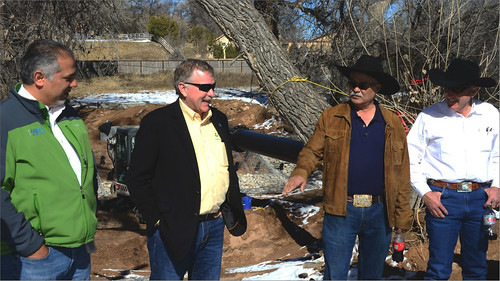
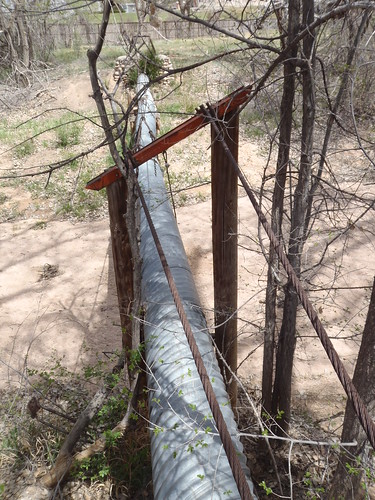

Posted by Rey Adame, Natural Resources Conservation Service, on March 29, 2016 at 4:00 PM

Xavier Montoya, State Conservationist for NRCS New Mexico (left) and Mark Rose (center left), NRCS director of financial assistance programs manager, talk about the successful partnerships and teamwork that led to the completion of the Las Joyas Acequia improvements near Nambe, New Mexico. Kenneth Salazar (center right), former president of the New Mexico Association of Conservation Districts and current President Jim Berlier (far right).
Spaniards built the Acequia de Las Joyas approximately 300 years ago. The acequia, a community irrigation watercourse or ditch, was the principal method of providing water to the farmers for their crop and rangelands in northern New Mexico. The parciantes (also known as acequia members) worked together to maintain the acequia and each member in return received a portion of the water.
Three centuries later, the practice is still key to making the land bloom. But, time and the elements have taken their toll on acequia and repair costs have escalated to the point that members can no longer shoulder the burden of maintaining the critical community resource alone.
In Santa Fe, USDA’s Natural Resources Conservation Service (NRCS) has been able to fill the gap, making it possible for members to revitalize the Acequia de Las Joyas using welded steel pipe and a concrete-lined watercourse to replace an aged, leaking flume structure with failing joints.

Before image of a sluice structure, flume and concrete lined ditch to convey water to the landowners downstream.
“It helps by allowing us to better use our water―our resource. In fixing the flume structure, we can run more water, more efficiently,” said Doug Hefele, an officer of the Acequia de Las Joyas. “We may be able to water more than one parciantes at a time.”
The repaired structure not only conserves water, but increases the quantity of water flowing through the flume―making more water available for the parciantes to irrigate their farmland.
The Acequia de Las Joyas was the first project approved in the country through the Regional Conservation Partnership Program (RCPP)―administered by NRCS in all 50 states and the Commonwealth of Puerto Rico. Through RCPP, NRCS and its partners help producers improve conservation practices and maintain conservation activities in eligible areas.
RCPP draws on local knowledge and networks to fuel conservation projects. Bringing together a wide variety of new partners including businesses, universities, non-profits and local and Tribal governments makes it possible to deliver innovative, landscape- and watershed-scale projects that improve natural resource concerns on working farms, ranches and forests.
Cooperation between NRCS, the Interstate Stream Commission, the New Mexico Association of Conservation Districts, the New Mexico Acequia Association and acequia parcientes, allowed a traditional irrigation method to continue serving the community.
Agriculture Secretary Tom Vilsack recently announced the availability of up to $260 million for RCPP partner proposals to improve the nation’s water quality, combat drought, enhance soil health, support wildlife habitat and protect agricultural viability. The funding will add to the nearly $600 million NRCS has invested in 199 partner-led projects since 2015.
This will be the third round of projects funded through RCPP, helping USDA build on record enrollments in voluntary conservation programs, with more than 500,000 producers participating to protect land and water on more than 400 million acres nationwide.
USDA is now accepting proposals for Fiscal Year 2017 RCPP funding. Pre-proposals are due May 5. For more information on applying, visit the RCPP website.

After image of a sluice structure, flume and concrete lined ditch to convey water to the landowners downstream.
Related Posts
‘Bee’ing at White House Day at the Lab
From the #USDA:
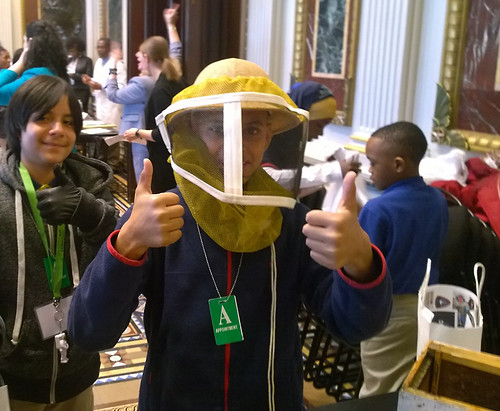

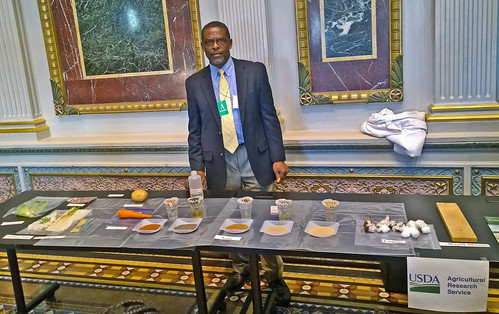
Posted by Jay Evans, Research Leader, Bee Research Lab, Agricultural Research Service, on March 29, 2016 at 10:00 AM

Students from Baltimore and Washington, D.C. schools try out different scientific careers like ARS bee researcher at the White House Day at the Lab.
“Whoa! Do you have bees in there?” is not something the Secret Service asks every day, even of scientists when they come to the Eisenhower Executive Office Building, which sits next to the White House West Wing and houses most of the staff offices.
It was just a month ago that agronomist Eton Codling, from the Agricultural Research Service (ARS) Crop Systems and Global Change Lab, and I, research leader of the ARS Bee Research Lab, were on our way into the White House. We were there to represent USDA at the White House Day at the Lab to give young students a taste of exciting science careers they may never have considered or even known about otherwise.
About 70 eager sixth, seventh and eighth graders from Washington, D.C. and Baltimore schools had the opportunity to spend the day doing experiments, being inspired by hands-on activities and the chance to ask questions of real working scientists from Federal agencies.
At my bee station, groups of students learned what I, as an entomologist, am doing to help make honey bees healthier and how scientists and beekeepers can safely work with bees. They also got to become familiar with bee wax and a beekeeper’s tools. The enthusiastic students wanted to know how much honey each bee can collect, why a queen bee is different if all worker bees in the colony are also female, and how many times I had been stung.

Entomologist Jay Evans, ARS Bee Research Lab, sets up a table of bee wax and bee-working tools at the White House Day at the Lab, where students had the chance to try being different types of scientists.
And at Dr. Codling’s soil table, the students were fascinated by changes in the color of pH strips, which tell how acid a liquid is, as they dipped the strips in water after they had been run through different types of soil. The students said they knew food was grown in soil, but they had never been taught how soil affects so many things—such as the fact that the air we breathe is changed by the plants that grow in the soil, and by the animals we eat that feed on the plants that grow in the soil. Everything is interconnected through the soil, and we need to stop treating it like dirt.
The White House Day at the Lab was held in coordination with My Brother’s Keeper—a program President Barack Obama launched two years ago to address persistent disadvantages and to ensure boys and young men of color have opportunities to reach their full potential—and with the White House Council on Women and Girls. It kicked off a week of similar events for students at Federal labs across the country.

Agronomist Eton Codling, ARS Crop Systems and Global Change Lab, is ready to teach students about different types of soil at the White House Day at the Lab.
Related Posts
Salmon Eggs and Developing Salmon Fry
From the U.S. Fish and Wildlife Service:
A close view of salmon eggs and developing salmon fry! The newly hatched salmon have a visible yolk sac attached that will provide nutrients as it's absorbed. Rare glimpse of the salmon life cycle in action.
#salmon #fish #lifecycle #nature #growingup#spring
A close view of salmon eggs and developing salmon fry! The newly hatched salmon have a visible yolk sac attached that will provide nutrients as it's absorbed. Rare glimpse of the salmon life cycle in action.
#salmon #fish #lifecycle #nature #growingup#spring
Tuesday, March 29, 2016
Red-Cockaded Woodpecker Populations Begin Rebound
From the #USDA:
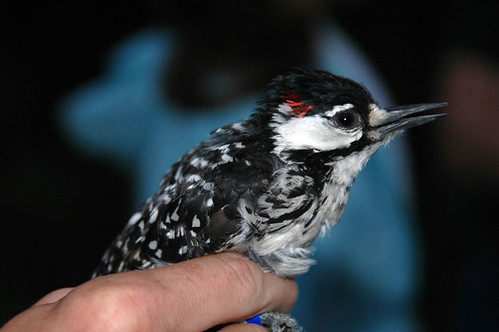
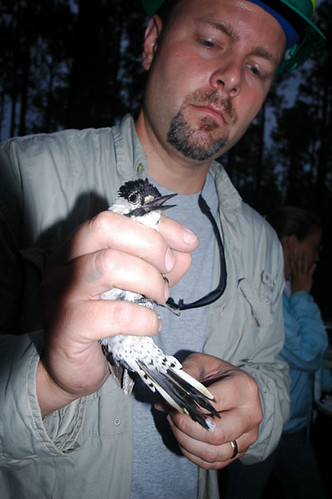

Posted by Caroline Roth, U.S. Forest Service Volunteer, on March 28, 2016 at 4:45 PM

A Forest Service employee monitors a red-cockaded woodpecker to track population trends and to identify birds that may be moved to other populations as part of the species’ translocation program. Photo credit: U.S. Forest Service/Chuck Hess
It isn’t often that an endangered species successfully recovers, which is why the story of the red-cockaded woodpecker is so inspiring.
Once found throughout 90 million acres of longleaf pine forests in the southeast, the red-cockaded woodpecker’s population on National Forest System lands today number approximately 3,150 active clusters of typically one to five birds each. This is a 60 percent increase from the low of 1,981 active clusters in 1990.
The biggest threat to this rare woodpecker’s existence today is the lack of suitable habitat, but theApalachicola National Forest provides a safe refuge for its largest population in the world.

Wildlife Biologist John Dunlap of the Apalachicola National Forest examines a red-cockaded woodpecker, which nests in the forest’s longleaf pine ecosystem. These woodpeckers are effective indicators of a healthy longleaf pine ecosystem. Photo credit: U.S. Forest Service/Susan Blake
John Dunlap, a Forest Service wildlife biologist on the Apalachicola is one of many biologists contributing to recovery efforts. According to Dunlap, the most critical component of habitat management is fire. The red-cockaded woodpecker evolved in a landscape that burned at two- to three-year intervals. In a pine forest, fire will keep hardwoods to a minimum and promote a grassy ground cover typical of a high-quality longleaf pine forest where many rare species can flourish.
“The most exciting thing in recent years has been the growth of the Wakulla Ranger District population. In the spring of 2005 there were 106 active clusters in this population. We are currently crunching the numbers for the spring 2015 season and we have our fingers crossed that we will hit 200,” said Dunlap.
When the surveys were completed, Apalachicola National Forest staff found 203 active red-cockaded clusters in 2015, marking another population milestone.
This fall, there are plans to relocate 15 pairs through the Southern Range Translocation Cooperative, with as many as five additional pairs being moved from the Apalachicola Ranger District population over to the Wakulla Ranger District.
The red-cockaded woodpecker has come a long way since it was listed as an endangered species in 1970.
“Although the RCW is still listed as endangered, this bird is a true success story,” said Dunlap. It seems the efforts of the Apalachicola National Forest to bring the species back have been incredibly successful.

Wildlife biologists band red-cockaded woodpeckers on the Apalachicola and Osceola national forests to monitor their nesting activities and population health on each forest. Photo credit: U.S. Forest Service/Susan Blake
Related Posts
People’s Garden Initiative Launches New Website to Celebrate National Garden Month
From the #USDA:

Posted by Annie Ceccarini, Program Manager, The People's Garden Initiative and USDA Farmers Market, on March 28, 2016 at 3:00 PM

Children get hands on experience in the garden at the exhibits during the 2016 White House Easter Egg Roll on the south lawn of the White House in Washington, DC on Monday Mar, 28, 2016. USDA photo by Lance Cheung.
Spring has sprung and April is National Garden Month! It’s time to pick up your trowel and get gardening.
USDA launched the new People’s Garden website that provides tools and resources gardeners can use to start or expand a home, school or community garden. Unveiled during today’s annual Easter Egg Roll at the White House, here are just some of the new features:
Those new to gardening can download community garden and school garden checklists created in partnership with Let’s Move or watch short videos about how-to raise tomato seedlings indoors or the benefits of installing a rain barrel.
Growing your own food is a great way to build a healthier plate. USDA’s MyPlate recommends that everyone fill half their plate with fruits and vegetables. With the new People’s Garden database, gardeners can now itemize the amount and type of fruits and vegetables picked from their People’s Garden. Each product is automatically converted to cups using SuperTracker, which helps gardeners better understand how their yield will feed them and others.
For the experienced gardeners who want to explore selling their produce, the new People’s Garden map connects them to nearby farmers markets and CSAs.
And that’s not all. Another exciting addition is the Plant a Window Box for Pollinators online game that has been a big hit at the White House Easter Egg Roll, created in cooperation with the Pollinator Partnership. It’s a fun, interactive tool that shows you how planting native species can increase the quality and amount of food available to neighborhood bees and other pollinators. Check it out.
Once you lay the groundwork and get growing, don’t forget to register your food, wildlife, conservation, beautification, education, or training garden with us as a People’s Garden. Since 2009, more than 1,300 partners have volunteered over 200,000 hours in 2,226 gardens resulting in donations of 3.9 million pounds of food.
Follow us throughout National Garden Month this April on Twitter @PeoplesGarden and share your garden stories using #NationalGardenMonth.
USDA’s Agricultural Marketing Service, Transportation and Marketing Program oversees the People’s Garden Initiative for the Department.
Related Posts
How USDA & Partners Eradicated Oriental Fruit Fly from Florida
From the #USDA:


Posted by John Stewart, Fruit Fly Policy Manager for the Plant Protection and Quarantine Program of USDA's Animal and Plant Health Inspection Service, on March 28, 2016 at 11:00 AM

Oriental fruit fly infestations can ruin more than 400 types of fruits and vegetables. Photo by Stephanie Gayle, USDA-ARS.
There’s a good reason why USDA and the Florida Department of Agriculture and Consumer Services (FDACS) constantly monitor more than 56,000 fruit fly traps they have strategically placed across Florida. An outbreak of exotic fruit flies—one of the most destructive pests of fruit and vegetables—could threaten Florida’s powerhouse agricultural industry. By detecting these pests early and responding rapidly, USDA, FDACS, county officials, and growers can avoid large-scale agricultural losses and keep valuable export markets open.
In August 2015, some of those traps captured Oriental fruit flies (OFF) in Miami-Dade County.
The OFF attacks more than 430 different fruits, vegetables, and nuts, including avocado, mango, guava, papaya, and pitaya. All of these crops and more grow in the county, which is Florida’s top producer of tropical fruit, tropical vegetables, and ornamental nurseries. The county’s $1.6 billion agricultural industry supports 11,000 jobs.
The detection triggered an emergency response that could be a case study in how USDA’s Plant Protection and Quarantine (PPQ) program and its partners respond to fruit fly outbreaks. Although responses vary depending on the fruit fly species, they all share a common framework, employing well-documented, science-based, and time-tested action plans:
- Quickly find the infestation’s boundaries by setting a delimiting area and monitoring additional traps in the affected area.
- Activate a team of government program experts, scientists, and state and local agriculture officials to assess the situation within the quarantined area.
- Conduct stakeholder meetings and enter into compliance agreements with every grower, harvester, processer, packer, shipper, wholesaler, and retailer in the quarantine area to ensure any potentially infested material is safe to move out of the area.
- Employ proven eradication strategies appropriate for the current infestation, such as removing fruit potentially infested with larvae and applying treatments to leaves and soil to eliminate the fruit fly population.
- Conduct public outreach through local PPQ offices, the state department of agriculture, Extension, master gardeners, local elected officials, and industry so the affected residents know about the quarantine and take action not to further spread the infestation.
- Continue surveying for three lifecycles after the last fruit fly is captured to verify eradication.
In areas at highest risk for Mediterranean or Mexican fruit flies, PPQ has another powerful tool: the release of billions of sterile male flies from airplanes annually. The sterile males suppress reproduction should any same-species wild female fruit flies enter the area (see the whole process in our “SIT – Florida’s Proactive Defense from Exotic Fruit Flies” video). If traps catch wild Mediterranean or Mexican fruit flies, PPQ may increase those sterile releases dramatically to help combat the infestation.
In the end, however, none of these strategies and tactics would work without PPQ’s strong state, local, and industry partnerships. Thanks to this close coordination in Florida, PPQ and FDACS declared OFF eradicated on Feb. 13, 2016, just six months after the first detection.
In 2015, the United States saw a record-setting 12 fruit fly infestations. Fortunately, we have eradicated 10 of them and are fast closing in on the others—because of proven strategies and effective partnerships.

A USDA pest identifier removes a captured fruit fly from a trap to determine its species.
Related Posts
Monday, March 28, 2016
South Bay Resident Charged With Illegal Dumping In Wetlands And Other Protected Waters
Department of Justice
U.S. Attorney’s Office
Northern District of California
FOR IMMEDIATE RELEASE
Monday, March 21, 2016
South Bay Resident Charged With Illegal Dumping In Wetlands And Other Protected Waters
SAN FRANCISCO – Violations of the Federal Clean Water Act were filed last week against James Philip Lucero for the unpermitted discharge of pollutants into waters of the United States, including wetlands, announced Acting United States Attorney Brian J. Stretch, Environmental Protection Agency Acting Special Agent in Charge Jay Green, Federal Bureau of Investigation Special Agent in Charge David J. Johnson, and Alameda County District Attorney Nancy E. O’Malley.
In the indictment filed March 15, 2016, and unsealed this afternoon, a federal grand jury charged Lucero, 59, of Carmel, Calif., a self-described “dirt broker,” with illegally discharging pollutants into waters of the United States adjacent to Mowry Slough, part of the Don Edwards San Francisco Bay National Wildlife Refuge located in Newark, Calif. As a dirt-broker, Lucero is alleged to have charged a fee to contractors and trucking companies in exchange for providing open space to dump fill material, including construction debris. The defendant is alleged to have caused construction debris and fill material to be dumped on property containing federally-protected wetland and other waters of the United States, without applying for or obtaining a permit from either the U.S. Army Corps of Engineers or the Environmental Protection Agency. According to the two count indictment, beginning on or about June 2014 and extending through on or about September 8, 2014, Lucero, without a permit, caused dirt, soil and other materials to be discharged from a point source into waters of the United States, including 11.85 acres of wetlands and 1.33 acres of other waters. Lucero is charged with one count of unpermitted filling of wetlands, in violation of 33 U.S.C. §§ 1311, 1319(c)(2)(A) and 1344, and one count of the filling of other waters, in violation of the same statutes.
Lucero was arraigned this morning before U.S. Magistrate Judge Donna M. Ryu. He is next scheduled to appear on April 25, 2016, before U.S. District Judge Haywood S. Gilliam for an initial appearance.
An indictment merely alleges that crimes have been committed, and all defendants are presumed innocent until proven guilty beyond a reasonable doubt. If convicted, the maximum statutory penalty for a violation of 33 U.S.C. §§ 1311, 1319(c)(2)(A) and 1344 is three years in prison and $50,000 fine. Additional fines, forfeitures, and a period of supervised release also may be imposed. However, any sentence following conviction would be imposed by the court after consideration of the U.S. Sentencing Guidelines and the federal statute governing the imposition of a sentence, 18 U.S.C. § 3553.
Assistant U.S. Attorney Philip J. Kearney is prosecuting the case with the assistance of paralegal Alycee Lane. The prosecution is the result of an investigation by the Environmental Protection Agency, the Federal Bureau of Investigation, the Alameda County District Attorney’s Office, and the Newark Police Department.
Red Fox Kit
From the U.S. Fish and Wildlife Service:
Red fox kits are born small and defenseless, but they grow quickly and can start to explore after about four weeks. Litters usually consist of four to six, but sometimes as many as 13!
Brad Smith, Creative Commons
Red fox kits are born small and defenseless, but they grow quickly and can start to explore after about four weeks. Litters usually consist of four to six, but sometimes as many as 13!
Brad Smith, Creative Commons
Sunday, March 27, 2016
Leave These Eggs in Their Basket!
From the U.S. Fish and Wildlife Service:
If you find eggs in this type of basket, please remember to leave them alone! These are bluebird eggs inside a nest box at West Virginia's Canaan Valley National Wildlife Refuge.
Saturday, March 26, 2016
Green Herons
From the USFWS Northeast Region:
Green herons are one of the world’s few tool-using bird species. They create fishing lures with bread crusts, insects, earthworms, twigs, feathers, and other objects, dropping them on the surface of the water to entice small fish. This beautiful bird was spotted at John Heinz National Wildlife Refuge At Tinicum by Kay Meng
Green herons are one of the world’s few tool-using bird species. They create fishing lures with bread crusts, insects, earthworms, twigs, feathers, and other objects, dropping them on the surface of the water to entice small fish. This beautiful bird was spotted at John Heinz National Wildlife Refuge At Tinicum by Kay Meng
"Who are you calling a Peep?"
From the USFWS Southeast Region:
"Who are you calling a Peep?"
(Photo: Snowy plover mom and chick, Penny Jarrett,MyFWC)
"Who are you calling a Peep?"
(Photo: Snowy plover mom and chick, Penny Jarrett,MyFWC)
Merriam Wild Turkeys in full display.
From the Bureau of Reclamation:
Merriam Wild Turkeys in full display.
Spring brings out the best in most Toms (male turkeys) in displaying for the Hens (female turkeys). These have been very successful after being introduced into the Lake Roosevelt Recreation Area behind Grand Coulee Dam. So successful, they have also moved into the town of Grand Coulee and Coulee Dam. Careful where you step! Photo by Craig Brougher, Hydrologic Technician with the Bureau of Reclamation, March 13, 2016. #scenic#wildturkeys #GrandCouleeDam
Merriam Wild Turkeys in full display.
Spring brings out the best in most Toms (male turkeys) in displaying for the Hens (female turkeys). These have been very successful after being introduced into the Lake Roosevelt Recreation Area behind Grand Coulee Dam. So successful, they have also moved into the town of Grand Coulee and Coulee Dam. Careful where you step! Photo by Craig Brougher, Hydrologic Technician with the Bureau of Reclamation, March 13, 2016. #scenic#wildturkeys #GrandCouleeDam
Northern harrier (male) in flight
From the U.S. Fish and Wildlife Service, Mountain-Prairie Region:
Northern harrier (male) in flight. Photo: Tom Koerner/USFWS
Northern harrier (male) in flight. Photo: Tom Koerner/USFWS
Marsh Wren
From U.S. Fish and Wildlife Service Midwest Region:
Marsh wrens are known for their noise. They spend all day singing songs, sometimes even into the night!
Photo: Marsh wren courtesy of Rich Leche/Creative Commons. https://flic.kr/p/9A3o5n
Marsh wrens are known for their noise. They spend all day singing songs, sometimes even into the night!
Photo: Marsh wren courtesy of Rich Leche/Creative Commons. https://flic.kr/p/9A3o5n
Tree Swallows
From U.S. Fish and Wildlife Service Midwest Region:
Tree swallows are cavity nesters that will also use available nest boxes. Watch for them in wooded swamps, marshes and near shorelines, zipping around eating insects!
Photo: Tree swallow courtesy of Rich Leche/Creative Commons. https://flic.kr/p/9xRVFh
Tree swallows are cavity nesters that will also use available nest boxes. Watch for them in wooded swamps, marshes and near shorelines, zipping around eating insects!
Photo: Tree swallow courtesy of Rich Leche/Creative Commons. https://flic.kr/p/9xRVFh
Friday, March 25, 2016
Rachel Carson
From the U.S. Fish and Wildlife Service, Mountain-Prairie Region:
In honor of Women’s History Month, we’re celebrating pioneering women in conservation like Rachel Carson - a former U.S. Fish and Wildlife Service employee whose work as an educator, scientist and writer mobilized America’s modern environmental movement.
Today, trailblazing women at the Interior Department are still making a difference. Learn about 5 amazing leaders in law, science and public engagement: http://on.doi.gov/1RlVMx6
In honor of Women’s History Month, we’re celebrating pioneering women in conservation like Rachel Carson - a former U.S. Fish and Wildlife Service employee whose work as an educator, scientist and writer mobilized America’s modern environmental movement.
Today, trailblazing women at the Interior Department are still making a difference. Learn about 5 amazing leaders in law, science and public engagement: http://on.doi.gov/1RlVMx6
Scotland ends coal-fired electricity
Scotland will today stop generating electricity from coal for the first time in more than 100 years.
The Longannet power station, north of the capital Edinburgh, switches off the last of its four generating units at 3 p.m. local time Thursday.
Scotland ends coal-fired electricity
Monitoring the Bears
From USFWS National Wildlife Refuge System:
How do bears in Kodiak, Alaska, know when salmon are running… or when the bears should look for other food? At Kodiak National Wildlife Refuge, biologists use bear cameras like this one and GPS collars to help answer those questions. Photo: Lisa Hupp/USFWS
How do bears in Kodiak, Alaska, know when salmon are running… or when the bears should look for other food? At Kodiak National Wildlife Refuge, biologists use bear cameras like this one and GPS collars to help answer those questions. Photo: Lisa Hupp/USFWS
Sage Grouse
From the U.S. Fish and Wildlife Service, Mountain-Prairie Region:
Imagine: The pungent scent of sagebrush rides the dawn as strange popping sounds like the uncorking of champagne bottles spill through the air. A dozen male #SageGrouse strut and fan their spiky tails, their bright yellow air sacs make the popping sound.
Occasionally two males battle, clubbing each other with their wings. Half-hidden in the sage, hens coolly observe the dancers, as they will for many mornings in spring before choosing a mate.
You’re witnessing an ancient ritual. Sage-grouse return to the same breeding grounds year upon year. Their elaborate courtship is often the focus of what we know about the bird, yet their life is fascinating at every stage and in every season.http://bit.ly/GrSageGrouse #USFWS
Photo credit: Doug Dance, All Rights Reserved
Imagine: The pungent scent of sagebrush rides the dawn as strange popping sounds like the uncorking of champagne bottles spill through the air. A dozen male #SageGrouse strut and fan their spiky tails, their bright yellow air sacs make the popping sound.
Occasionally two males battle, clubbing each other with their wings. Half-hidden in the sage, hens coolly observe the dancers, as they will for many mornings in spring before choosing a mate.
You’re witnessing an ancient ritual. Sage-grouse return to the same breeding grounds year upon year. Their elaborate courtship is often the focus of what we know about the bird, yet their life is fascinating at every stage and in every season.http://bit.ly/GrSageGrouse #USFWS
Photo credit: Doug Dance, All Rights Reserved
Symbiosis
From the U.S. Fish and Wildlife Service, Mountain-Prairie Region:
Symbiosis: interaction between two different organisms living in close physical association, typically to the advantage of both.
That just about sums up what's going on between this magpie and these moose calves on Seedskadee National #WildlifeRefuge. The bird gets a free meal, while the moose are rid of ticks and other parasites that can lead to a number of serious health issues, some of which can be fatal.
Photo: Tom Koerner / #USFWS
Symbiosis: interaction between two different organisms living in close physical association, typically to the advantage of both.
That just about sums up what's going on between this magpie and these moose calves on Seedskadee National #WildlifeRefuge. The bird gets a free meal, while the moose are rid of ticks and other parasites that can lead to a number of serious health issues, some of which can be fatal.
Photo: Tom Koerner / #USFWS
Thursday, March 24, 2016
White-Tailed Jack
From the U.S. Fish and Wildlife Service, Mountain-Prairie Region:
When Lewis and Clark traveled west, they wrote at length about an amazing hare they encountered - the "White-Tailed Jack". They not only revered its fine fur, but with specimens weighing in at up to ten pounds, these jackrabbits made hearty meals for the hungry travelers. However, with a top speed of 40 mph and keen hearing and intelligence, they were quite difficult to catch!
Read all about this amazing creature:http://bit.ly/1UaqXz5
Photo: Tom Koerner / #USFWS
When Lewis and Clark traveled west, they wrote at length about an amazing hare they encountered - the "White-Tailed Jack". They not only revered its fine fur, but with specimens weighing in at up to ten pounds, these jackrabbits made hearty meals for the hungry travelers. However, with a top speed of 40 mph and keen hearing and intelligence, they were quite difficult to catch!
Read all about this amazing creature:http://bit.ly/1UaqXz5
Photo: Tom Koerner / #USFWS
Black-bellied Plover
From the U.S. Fish and Wildlife Service Midwest Region:
The black-bellied plover is often found along coasts, but will occasionally pass through during migration. With a wingspan of nearly 24 inches, this is the largest plover in North America!
Photo: Black-bellied plover courtesy of Jerry McFarland/Creative Commons.https://flic.kr/p/s4EUyq
The black-bellied plover is often found along coasts, but will occasionally pass through during migration. With a wingspan of nearly 24 inches, this is the largest plover in North America!
Photo: Black-bellied plover courtesy of Jerry McFarland/Creative Commons.https://flic.kr/p/s4EUyq
Petroglyphs, Grinding Rocks and Hollywood Meet in NRCS Training Session
From the #USDA:
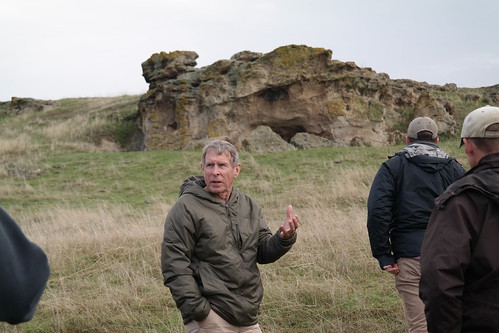
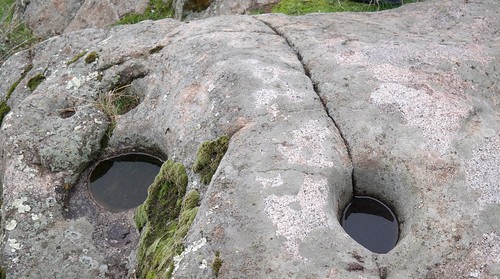

Posted by Anita Brown, and Chris Robbins, Natural Resources Conservation Service, on March 24, 2016 at 1:00 PM

Ben Barnette explains the significance of the rock formation in a two-day training session. Photo: Chris Robbins.
The day was brisk, the air was fresh, and the subject of the day was captivating. Sixteen Natural Resources Conservation Service (NRCS) field conservationists in California had just sat through a day of classroom-style instruction on cultural resources policy, law and identification. Now they trudged along behind California State Archaeologist Ben Barnette to practice their skills in a field setting.
“It all seemed fairly ordinary,” said Soil Conservationist Chris Robbins. “We stopped at a ranch and hiked over to an unremarkable rock formation jutting from the rolling landscape. But it turned out to be a rock shelter that was used by Native Americans—with plenty of evidence to prove it. They left their marks on the walls as well as pieces of artifacts scattered nearby.”
Barnette says students new to cultural resources often have Robbins’ reaction. “If they just have the book portion of the training it’s rather ho hum,” says Barnette. “Then they get out on a piece of land and it’s clarified for them. It becomes exciting. They realize people lived here—right here—hundreds or thousands of years ago.” Barnette says this realization naturally leads people to ask: ‘What were they doing here?’
And archeology proceeds from there, he says.

Bedrock mortars like these were used to process food such as acorns and are plentiful in California. Elsewhere in the southwest more portable grinding devices like matates are more common. Photo: Chris Robbins.
These messages from past peoples are remarkable cultural treasures—despite sometimes being found in fairly unremarkable settings. Knowing where the treasures are is the first step in protecting them. That’s why NRCS and other federal agencies are required to do cultural resource surveys before undertaking work on the land, as explained in the Historic Preservation Act of 1966.
In California, NRCS does this work in consultation with the State Historic Preservation Office, or SHPO. Areas that haven’t already been surveyed—or that have been made exempt for various reasons—are surveyed by one of NRCS’ four archeologists. Conservationists, like Robbins, are now getting the chance to do small (less than 20 acres) surveys. After two days of training the recruits can become certified as cultural resource technicians.
The Orvis Cattle Company ranch where Robbins’ training took place has hosted NRCS cultural resource trainings for decades, says District Conservationist Diana Waller. “They have also allowed our soil surveyors to dig pits there, and they have covered the ranch with an easement —partially funded by NRCS—that will keep these treasures protected into perpetuity.”
“Our family has always protected these sites,” says Don Harper, partner of Orvis Cattle Co. “We realize the worth of these wonderful places, and we have welcomed NRCS, universities and other entities to study here in the past.”
Robbins continues to describe his training experience: “The past people on the site left shards of chert that pierced the damp soil surrounding the rock overhang. It was like they had left us a clue to at least one of the activities they did at this site. They made tools here. We do not know if there were projectile points or knives or scrapers, but the fact was that the tools were evidence of their presence, left behind for us to find, hundreds, maybe thousands of years later.”
Several hundred years after the Native Americans left chert tools and petroglyphs on the site, another culture visited with a rather different purpose in mind: Hollywood used the hillside to film the pilot episode and opening sequence of The Little House on the Prairie. Barnette says that as he shared this information with the class they all fired up their iPhones to immediately compare their surroundings to the show on YouTube.
In California, NRCS has trained dozens of cultural resource technicians in the last five years. It helps to balance the archeology workload and many employees like Robbins find it adds an unexpectedly exciting element to their job. “I look forward to using this knowledge to conduct cultural resources surveys,” he says, “and I know I will use it when hiking and exploring with my family.”
“We owe a debt of gratitude to families like the Harpers,” says Barnette. “It makes it possible to spread this knowledge to young people like Robbins who can help us protect similar sites across California and the Nation.”

Petroglyphs located on the wall of the rock shelter. Photo: Chris Robbins.
Related Posts
Fashion: A Look at Clothing Beyond Cotton and Leather - SPIEGEL ONLINE
Do you know how bad your jeans are for the environment? Or how many chemicals are needed to produce a pair of leather shoes? Luckily, there are some more environmentally friendly options available.
Fashion: A Look at Clothing Beyond Cotton and Leather - SPIEGEL ONLINE
Fashion: A Look at Clothing Beyond Cotton and Leather - SPIEGEL ONLINE
Wednesday, March 23, 2016
Whooping Cranes
From Quivira National Wildlife Refuge:
On the flats this morning: 4 adult Whooping Cranes. These were first reported last night, and were still present at first light today. It is always a treat to see these!
On the flats this morning: 4 adult Whooping Cranes. These were first reported last night, and were still present at first light today. It is always a treat to see these!
Kentucky “Landowner of the Year” Makes Conservation a Way of Life
From the #USDA:


Posted by Katherine Belcher, Natural Resources Conservation Service, on March 23, 2016 at 1:00 PM

Burchel Blevins of Knox County, was named the ‘Landowner of the Year’ for the southeastern region, by the Kentucky Department of Fish and Wildlife.
When Burchel Blevins drives visitors around his rural Kentucky farm, he points out the numerous conservation practices he has implemented to protect and preserve his land. Blevins owns more than 650 forested acres and 70 acres of open forest and grass land in different parts of Knox County, and he’s worked with USDA’s Natural Resources Conservation Service (NRCS) for about 15 years.
“You learn a lot working with them,” said Blevins, referring to NRCS staff.
Using NRCS programs like the Environmental Quality Incentives Program (EQIP), Conservation Stewardship Program, Wetland Reserve Easement (WRE) and the former Wildlife Habitat Incentive Program (now part of EQIP), Blevins has made many conservation improvements to his land.
He created snags and den trees to enhance wildlife populations and improve timber quality and production; established native warm-season grasses to benefit wildlife; planted a variety of grasses on a one-acre plot to attract pollinators; utilized patch clearcutting to create new and improved wildlife habitats that will provide an influx of annual plants and food sources; installed shallow water areas for wildlife and amphibians; and maintains wildfire breaks. And, he has more than 30 acres enrolled in a perpetual wetland reserve easement that takes marginal agricultural land and converts it back into natural wetlands.
Blevins work doesn’t go unrecognized. The Kentucky Department of Fish and Wildlife awarded Blevins as “Landowner of the Year” in Kentucky’s southeast region, citing his continued dedication to conservation maintenance, improving wildlife habitat – as well as improving education, outreach and recreational activities.
“This award meant a lot to me because I really appreciate the opportunity to do this,” said Blevins. “The land has been good to us and we can do the same.”
His conservation work is especially important in Knox County, which is a persistent poverty area targeted by USDA’s StrikeForce Initiative for Rural Growth and Opportunity. In StrikeForce areas, NRCS staff works with state, local and community officials to increase awareness of USDA programs and help build program participation through intensive community outreach and technical assistance.
On January 15, 2016, Vilsack announced the expansion of StrikeForce into high-poverty counties in Florida, Missouri, Montana and Ohio. Altogether, 970 counties, parishes, boroughs and census areas in Alabama, Alaska, Arizona, Arkansas, Colorado, Florida, Georgia, Kentucky, Louisiana, Mississippi, Missouri, Montana, Nevada, New Mexico, North Carolina, North Dakota, Ohio, Oklahoma, Puerto Rico, South Carolina, South Dakota, Tennessee, Texas, Utah, Virginia and West Virginia are now eligible for “intensive care” through StrikeForce.
Farmers interested in learning more about conservation and land management practices, visitwww.nrcs.usda.gov/GetStarted.

Blevins installed this pond near a grove of chestnut trees to serve as a food source for wildlife on his land.
Related Posts
Subscribe to:
Posts (Atom)

















